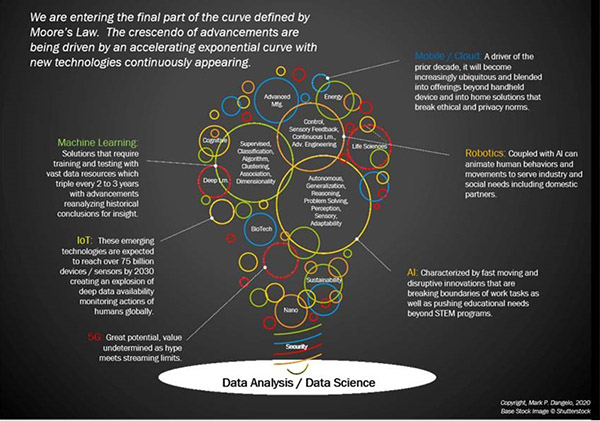
Mark P. Dangelo: The Challenges of Reskilling Workforces, Part 2

(Mark P. Dangelo is president of MPD Organizations LLC, featuring books, industry reports and articles. He is a strategic management consultant, outsourcing advisor and analytics specialist with extensive process, technology and financial results and is a frequent contributor to MBA NewsLink. He can be reached at mark@mpdangelo.com or at 440/725-9402.)
(This is part 2 of a series. Part 1 can be accessed at https://newslink.mba.org/mba-newslinks/2020/january/mark-p-dangelo-the-challenges-of-reskilling-workforces-part-1/.)
As we think about the demands for reskilling workforces, it is overshadowed by the movement of the Doomsday Clock now at 100 seconds—the closest time to midnight ever “posted” regarding the likely extinction of humankind.
Why do I bring this up? It is about scaring the hell out of you, or as management consultants like to charge you for, “creating the burning platform?” Should reskilling even be a concern against the backdrop of huge climate challenges and caustic politics? With rising sea levels and temperatures, global famine and unchecked populations, it would seem the time is nigh for anything except macro issues—and reskilling workforces is not consistently in the top 10.
However, unlike those “learned” individuals who contemplate the end of humans, I find myself increasingly contemplating the fate of unprepared humans—those who lack the skills and capabilities to survive the expansion of the Fourth Industrial Revolution, or what some have coined “Industry 4.0.” We have an Innovation Predicament created by rapid adoption of hyper accelerated innovation without understanding fully the ramifications and believing that all innovation is benevolent. The diagram below highlights just a few of the many innovations changing business delivery and customer expectations.

An intensifying challenge for reskilling of existing worker involves caustic local and national politics. Individuals are bringing their polarized beliefs and values to work with them resulting in management challenges previously not seen since the Vietnam War. As divisions grow progressively vemonistic across factories, offices and universities, so do the challenges of adapting to growing digital demands by existing workers who do not have the required competencies. These political animosities spill over into delivery supply chains (e.g., partners, outsourcers) making it more difficult and expensive to serve the customer and recognize corporate profitability.
To reinforce these occurrences, from a recent poll by the Society for Human Resource Management, 59% of workers state that politics have become more of an issue compared to four years prior. Additionally, as the 2020 U.S. presidential elections draw closer, the dysfunctionality between working peers is anticipated to rise significantly as tensions come to the surface and divisive topics presented by candidates as “us versus them.” The demands for reskilling due to innovational progression are extraordinary—but so are the limiting factors inhibiting enterprise efforts.
Organizational Restrictions and Operational Transformations
Achieving order from chaos is a foundational idea behind organizational design since the days of Henry Ford. As enterprises became more complex and workers skills specialized, the design of the organization became the specialty of academics and consultants seeking to eliminate internal divisions, make workers accountable and efficient and allow for segregation of duties necessary to blend ideas into services and products. During the prior iterations before 4IR, enterprise leaders delivered customer needs based on the use of departments and divisions, who like an army with a mission, executed their assigned tasks.
However, with 4IR now becoming more than a curiosity, the very organizational premises which brought rigor and discipline to diverse workforces are now creating for enterprises an insulating effect when it comes to reskilling. We can witness this as organizations compartmentalize their professional development dollars during quarterly and yearly budgeting processes. As we know, reskilling money is often allocated based on divisional or department contributions rather than assessed needs. Rewards and performance assessments are determined by direct success and not necessarily the less-profitable divisions and departments which round out the enterprise and its branding.
Additionally, noted consultancy McKinsey stated in its report, The Skilling Challenge:
“Required future skills are not just digital skills: human and meta skills also become extremely important. It is not the quantity of jobs that is the issue, but rather that there is a gap between skill requirements of the old and new jobs. This skill mismatch could become the main problem for the labor market.”
Combine their positioning with the reality that most enterprises (for the past four decades) are project-based, then reskilling workforces becomes a by-product of an initiative. Pointedly, delivery of a project (or larger program) is tied to profitability and market share, the value of reskilling dollars spend is painted with the failure rate of these initiatives, which often exceed 70%.
The following graphic provides challenge points enterprises will face as demand for reskilling outpaces the ability to deliver especially within traditional approaches of professional development. Underlying within this chart is a hidden nuance—organizational leadership confidence in traditional academic approaches is misplaced resulting in a reduced return for investments incurred.

The void of skills, as evidenced by the huge gap in demand versus availability, shows the fallacies of traditional approaches coupled with the eight-fold rise of educational costs versus usage potential. The idea that it is the individuals’ responsibility to “stay current” is now a proven fallacy that enterprises can no longer ignore.
As a consequence of the failed and segmented reskilling strategies and actions, enterprises will increasingly be turning to new forms of outsourcing, competency learning, and layered or stacked solutions, which rely heavily on orchestration of personnel and capabilities. That is, unless enterprises decide that they need to holistically address their reskilling strategy to meet the challenges facing their success. Without consequential changes in approaches tied to strategy, the demand for reskilling may usher in a huge market opportunity for outsourcers looking beyond BPO and KPO augmentation (see forthcoming Part 3).
Speaking Heresy–Challenging Conventions and Convictions
There is a transformative question that is now being bantered around enterprise leadership ranks. A question unprecedented in its nature and debated with greater efficacy:
Have traditional educational and training approaches failed to anticipate innovation or has innovation simply outmatched institutions chartered with providing individuals able to work within stated disciplines?
As you can see, this series of articles will examine not only what is missing within enterprise efforts to hire the “best, most qualified” people, but also the huge chasms of efforts missing to reskill existing workforces. Missing within most professional development programs are objective and comprehensive (competency) baselines for each employee and the mapping to future needs—and reviewed and addressed more than yearly or quarterly.
So why am I advocating such a heinous position that traditional education failed? Is it the nearly $2 trillion in student loans (with average student college debt is more than $30,000)? Is it the fact that during the past 15 years, college tuition at state or public schools has jumped more than 220% against near stagnant wages tied to inflation? Perhaps, if you’re not convinced the current approaches are correct, I can point out:
–Enterprises in the U.S. spend more than $200 billion (est.) on employee training and education. Of that, 65% comprises in-house training and costs. Less than 15% is for direct tuition reimbursement. Of the total, corporate leaders indicate 50% to 65% is wasted.
–More than 75% of existing personnel feel that they lack the training and skills needed to perform their current jobs and more than 90% believe that their company does not invest in existing personnel for their future.
–Current and prospective personnel believe automated screening, that is, artificial intelligence filtering, does not represent the true potential of workers against the tasks needed now and in the future. They are less likely to work for employers who use ratings and intelligence blackboxes to manage advancement.
–Only 10% of employees believe they have the digital skills needed for current assignments—let alone the future.
Whereas organizations often during times of slowing sales and economic malaise reduce reskilling of employees, enterprise profitability is reduced to one-third when compared to similar competitors. To highlight challenges against traditional mindsets, the following diagram show the varied approaches, intents and demands facing enterprises as they compare innovative needs against traditional solutions.

Reskilling, to the surprise of some enterprise leaders, begins with corporate strategy. Materially absent from strategy identification and execution, are the extensive challenges needed to reskill existing employees on hyper accelerated innovation often referred to in industry press as disruption (also noted in The Ramifications of Innovation Singularity, 2019).
Innovation has become so invasive, so common, that consumers and providers often miss how it has changed human behaviors and social constructs. These rapid economic, demographic and business changes have exceeded the abilities of educational institutions to adapt. Disruptive innovation is breaking the axioms held when it comes to reskilling of workforces. However, as all the above words and diagrams demonstrate, what will enterprises do now, in 2020, to aid not only their profitability, but the growth of their workforces?
It is true, that across demographics and politics, divisiveness is the currency. However, when it comes to reskilling of workforces, this is one payment option that cannot be accepted. If reskilling of workforces is not addressed strategically and with vastly improved ROI, it paints a bleak picture for economic prospects not only of recent college graduates, but for all demographic segments striving to actively participate in increasingly gig-based revenue models.
In Part 3 of this series, we will venture into four distinct reskilling models and the benefits and perils posed by their adoption.
(Views expressed in this article do not necessarily reflect policy of the Mortgage Bankers Association, nor do they connote an MBA endorsement of a specific company, product or service. MBA NewsLink welcomes your submissions. Inquiries can be sent to Mike Sorohan, editor, at msorohan@mba.org; or Michael Tucker, editorial manager, at mtucker@mba.org.)
